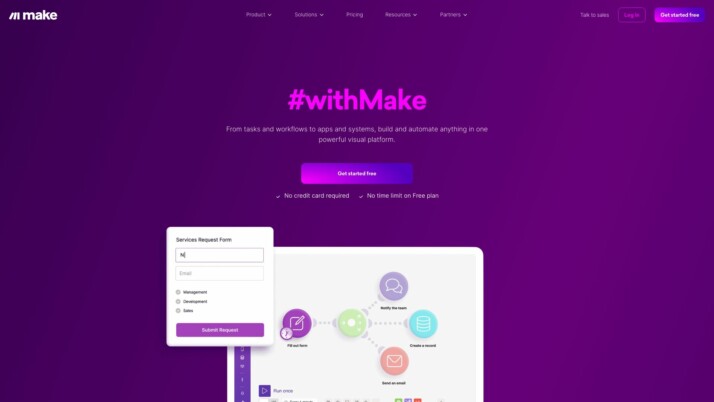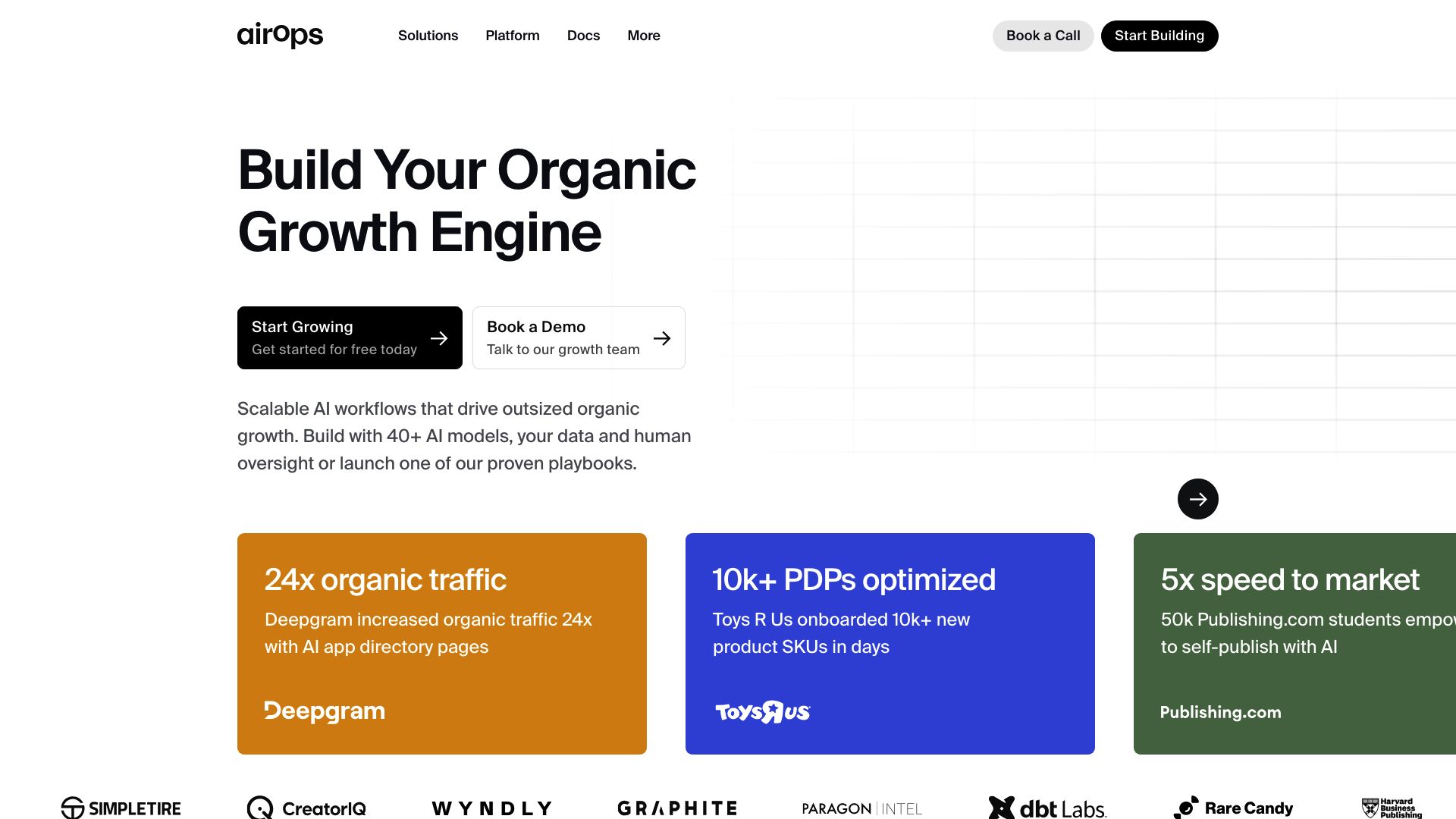Make.com vs. AirOps: Comparing AI Automation Platforms
AI-powered automation platforms are reshaping how businesses operate, innovate, and grow. This comparison explores Make.com’s visual workflow builder, AirOps’ AI-driven growth engine, and SmythOS’s comprehensive AI agent ecosystem. We’ll dive into each platform’s strengths, limitations, and unique features to help you choose the right tool for your automation needs.
Whether you’re a developer seeking advanced AI capabilities, a business leader focused on scalability, or a non-technical user looking for accessible solutions, this review provides insights to guide your decision-making process. Discover how these platforms stack up in terms of integration capabilities, AI features, security measures, and overall flexibility to empower your organization’s digital transformation journey.
Make.com Overview
Make.com empowers users to create sophisticated automation workflows without coding. The platform’s visual interface allows drag-and-drop creation of ’scenarios’ — interconnected sequences of actions across multiple apps and services.


Make.com excels at streamlining repetitive tasks and data flows for businesses of all sizes. Marketing teams can automate lead nurturing campaigns, while IT departments integrate disparate systems. The platform connects over 1000 popular apps and provides access to custom API integrations, enabling workflows tailored to specific business needs.
Make.com excels at streamlining repetitive tasks and data flows for businesses of all sizes. Marketing teams can automate lead nurturing campaigns, while IT departments integrate disparate systems.
The scenario builder offers granular control over data transformations, conditional logic, and error handling. Users can schedule automations to run at set intervals or trigger them via webhooks. Detailed execution logs and a testing environment facilitate debugging and optimization.
While Make.com provides powerful automation capabilities, it lacks some advanced AI features found in dedicated agent platforms. The focus remains on connecting existing tools rather than building autonomous AI agents. Users seeking complex natural language processing or machine learning may need to integrate external AI services.
Make.com’s collaboration features allow teams to work together on automation projects. Role-based access controls and shareable components promote efficient workflow development across organizations. The platform scales from free personal use to enterprise deployments, with pricing based on the number of operations and connected apps.
AirOps Overview
AirOps empowers businesses to build scalable AI workflows that drive organic growth. The platform enables users to create and implement workflows using over 40 AI models, proprietary data, and human oversight. AirOps offers proven playbooks that enhance various business functions, including SEO optimization, product listing management, and content creation.


The platform’s key features include scalable AI workflows that efficiently handle large volumes of tasks, reducing manual effort and optimizing processes. AirOps showcases real-world success stories, demonstrating significant boosts in metrics like organic traffic, speed to market, and conversion rates. For example, Deepgram increased their organic traffic by 24 times using AirOps.
AirOps showcases real-world success stories, demonstrating significant boosts in metrics like organic traffic, speed to market, and conversion rates. For example, Deepgram increased their organic traffic by 24 times using AirOps.
AirOps integrates with various tools and data sources, allowing for highly customizable and flexible workflow setups. Users can incorporate text, image, and transcription models along with data retrieval and human review steps. This flexibility makes AirOps suitable for a wide range of industries and use cases.
One of AirOps’ standout products is the AI Data Sidekick, a tool designed to help data practitioners write, optimize, and troubleshoot SQL queries and build Python models more efficiently. This tool includes AI-powered recipes available across multiple platforms such as dbt Cloud, Snowflake, Amazon Web Services QuickSight, and Mode Analytics.
While AirOps offers powerful AI workflow capabilities, it lacks some features found in more comprehensive AI agent builders. The platform does not provide hosted agents specifically categorized for development and production environments, nor does it offer autonomous agents or multi-agent collaboration features. Additionally, AirOps does not include a dedicated debug mode or multimodal capabilities, which may limit its application in certain complex AI scenarios.
Feature Comparison
Make.com and AirOps offer distinct approaches to workflow automation and AI integration, with notable differences in their core capabilities and security features. Make.com excels in visual workflow building and extensive app integrations, while AirOps focuses on AI-driven workflows for business growth.
Make.com provides a robust visual builder and no-code editor, allowing users to create complex automations without coding. However, it lacks AI-specific features like autonomous agents, memory and context capabilities, and multimodal interactions. AirOps, conversely, leverages over 40 AI models but doesn’t offer a dedicated visual builder or no-code option, potentially limiting accessibility for non-technical users.
In terms of security, Make.com ensures data encryption and OAuth support, crucial for protecting sensitive information in automated workflows. AirOps’ documentation doesn’t explicitly mention these security features, which may be a concern for businesses handling confidential data.
Neither platform offers hosted agents specifically for development and production environments, constrained alignment capabilities, or advanced features like deploy as GPT. This gap in core AI agent functionalities sets both platforms apart from more specialized AI agent builders.
Make.com’s strength lies in its extensive third-party integrations and API support, making it versatile for various automation tasks. AirOps, while more limited in general integrations, focuses on AI-specific workflows that can significantly impact business metrics like organic traffic and conversion rates.
Both platforms lack some advanced AI features such as foundation models, Huggingface AI integration, and hosted vector databases. These limitations may impact users seeking cutting-edge AI capabilities or requiring complex data handling for their workflows.
Feature Comparison Table
| Make.com | AirOps | SmythOS | |
|---|---|---|---|
| CORE FEATURES | |||
| AI Agents | ❌ | ✅ | ✅ |
| Hosted Agents (Dev, Production) | ❌ | ✅ | ✅ |
| Environments (Dev, Production) | ❌ | ✅ | ✅ |
| Memory & Context | ❌ | ✅ | ✅ |
| Autonomous Agents | ❌ | ✅ | ✅ |
| Explainability & Transparency | ❌ | ❌ | ✅ |
| Multimodal | ❌ | ✅ | ✅ |
| Problem-Solving Capabilities | ❌ | ✅ | ✅ |
| Multi-Agent Collaboration | ❌ | ✅ | ✅ |
| Human-AI Interaction | ❌ | ✅ | ✅ |
| SECURITY | |||
| Constrained Alignment | ❌ | ❌ | ✅ |
| Data Encryption | ❌ | ✅ | ✅ |
| IP Control | ❌ | ✅ | ✅ |
| COMPONENTS | |||
| Foundation AIs | ❌ | ✅ | ✅ |
| Huggingface AIs | ❌ | ✅ | ✅ |
| Zapier APIs | ❌ | ✅ | ✅ |
| Classifiers | ❌ | ✅ | ✅ |
| Data Lakes | ❌ | ✅ | ✅ |
| DEPLOYMENT OPTIONS (EMBODIMENTS) | |||
| Deploy as API | ❌ | ✅ | ✅ |
| Staging Domains | ❌ | ✅ | ✅ |
| Production Domains | ❌ | ✅ | ✅ |
| Deploy as Site Chat | ❌ | ✅ | ✅ |
| DATA LAKE SUPPORT | |||
| Hosted Vector Database | ❌ | ✅ | ✅ |
| Sitemap Crawler | ❌ | ✅ | ✅ |
| YouTube Transcript Crawler | ❌ | ✅ | ✅ |
| URL Crawler | ❌ | ✅ | ✅ |
| PDF Support | ❌ | ✅ | ✅ |
| Word File Support | ❌ | ✅ | ✅ |
| TXT File Support | ❌ | ✅ | ✅ |
Best Alternative to Make.com and AirOps
SmythOS stands out as the superior alternative to Make.com and AirOps, offering a comprehensive AI agent development platform that combines ease of use with powerful capabilities. Our drag-and-drop interface enables users to create sophisticated AI workflows without extensive coding knowledge, making advanced AI functionalities accessible to a broader audience.
SmythOS stands out as the superior alternative to Make.com and AirOps, offering a comprehensive AI agent development platform that combines ease of use with powerful capabilities.
Unlike Make.com’s limited AI capabilities and AirOps’ focus on specific business metrics, SmythOS provides a versatile environment for building autonomous agents that can handle complex tasks across various domains. We support multimodal interactions, allowing agents to process and respond to text, voice, and visual inputs, vastly expanding the potential applications of AI in your business processes.
SmythOS excels in providing a robust security framework, including data encryption and OAuth support, addressing the concerns that Make.com and AirOps may overlook. Our platform also offers constrained alignment capabilities, ensuring that AI agents operate within defined ethical and operational boundaries—a critical feature for businesses concerned about AI governance.
Our platform’s ability to deploy AI agents as APIs, chatbots, or scheduled tasks surpasses the limited deployment options of Make.com and AirOps. This flexibility allows you to integrate AI seamlessly into existing systems or create standalone applications that can transform your business operations. Additionally, SmythOS supports a wide range of AI models and integrations, including Hugging Face and foundation models, providing you with cutting-edge AI capabilities that our competitors lack.
SmythOS supports a wide range of AI models and integrations… providing you with cutting-edge AI capabilities that our competitors lack.
By choosing SmythOS, you’re not just getting a tool—you’re gaining a comprehensive AI ecosystem that can adapt to your evolving needs. Whether you’re automating customer interactions, analyzing complex data sets, or developing innovative AI applications, SmythOS provides the power, flexibility, and ease of use to bring your ideas to life faster and more efficiently than ever before.
Conclusion
Make.com and AirOps offer powerful automation solutions, each with unique strengths. Make.com excels in visual workflow creation and extensive app integrations, making it ideal for businesses seeking to streamline operations across multiple platforms. AirOps, with its focus on AI-driven workflows, delivers impressive results in areas like SEO optimization and content creation.
However, SmythOS emerges as the superior choice, combining the best of both worlds while addressing their limitations. Our platform provides a comprehensive suite of AI agent capabilities, from visual building to advanced features like multimodal interactions and autonomous agents. We offer unparalleled flexibility in deployment options, allowing you to create AI solutions once and deploy them anywhere – from chatbots to APIs to scheduled tasks.
Unlike Make.com and AirOps, SmythOS supports hosted agents for both development and production environments, ensuring a smooth transition from testing to live implementation. Our platform also excels in security, offering robust data encryption, OAuth support, and IP control features that are crucial for enterprise-grade deployments.
Experience the future of AI automation with SmythOS. Create a free account today and discover how our platform can revolutionize your workflow. With our comprehensive documentation and extensive integration ecosystem, you’ll be building sophisticated AI agents in no time. Don’t just automate – innovate with SmythOS.
Last updated:
Disclaimer: The information presented in this article is for general informational purposes only and is provided as is. While we strive to keep the content up-to-date and accurate, we make no representations or warranties of any kind, express or implied, about the completeness, accuracy, reliability, suitability, or availability of the information contained in this article.
Any reliance you place on such information is strictly at your own risk. We reserve the right to make additions, deletions, or modifications to the contents of this article at any time without prior notice.
In no event will we be liable for any loss or damage including without limitation, indirect or consequential loss or damage, or any loss or damage whatsoever arising from loss of data, profits, or any other loss not specified herein arising out of, or in connection with, the use of this article.
Despite our best efforts, this article may contain oversights, errors, or omissions. If you notice any inaccuracies or have concerns about the content, please report them through our content feedback form. Your input helps us maintain the quality and reliability of our information.
